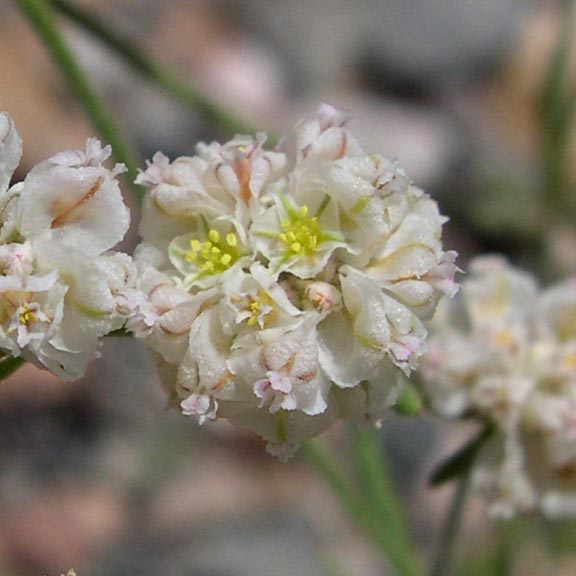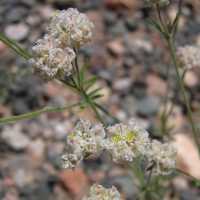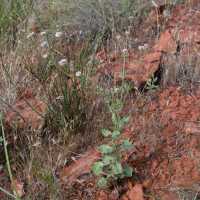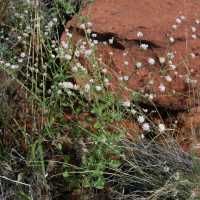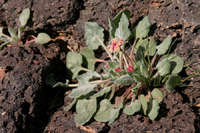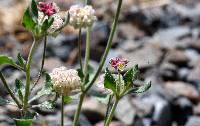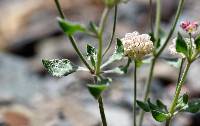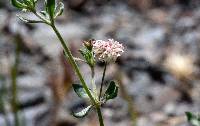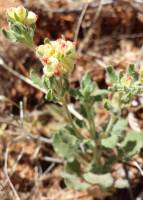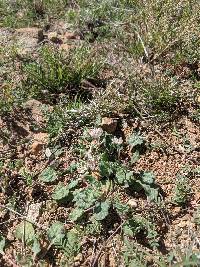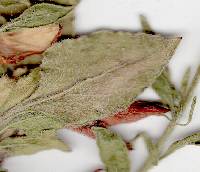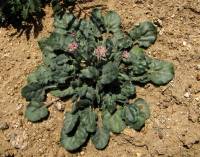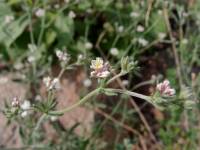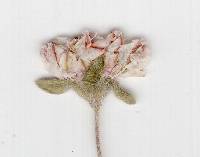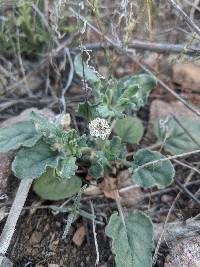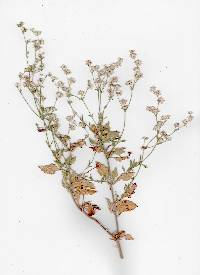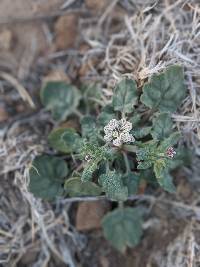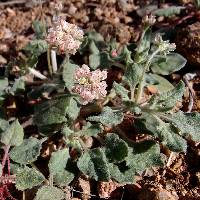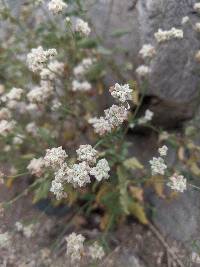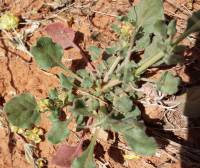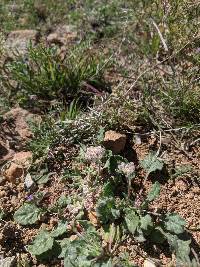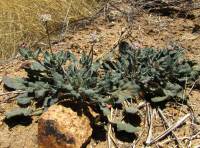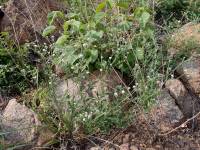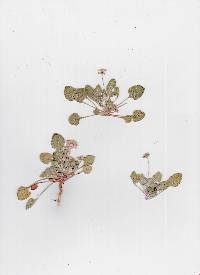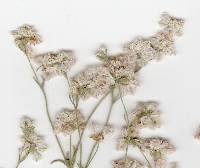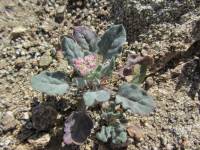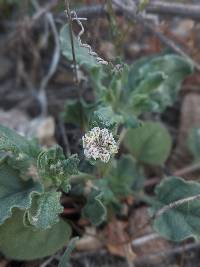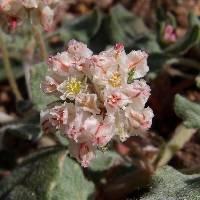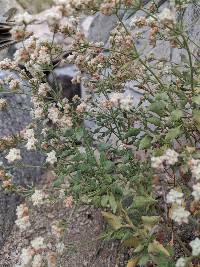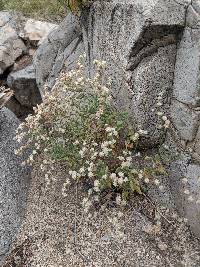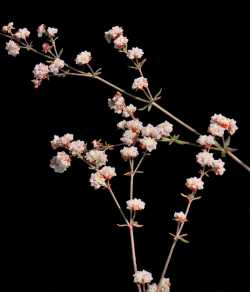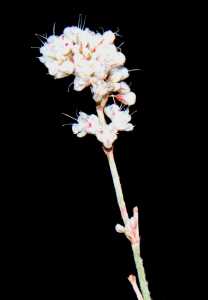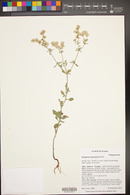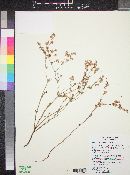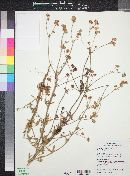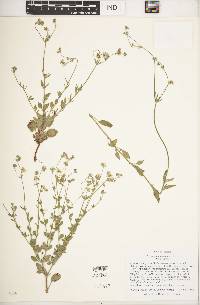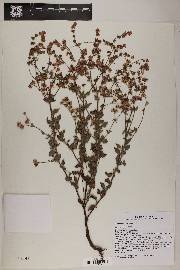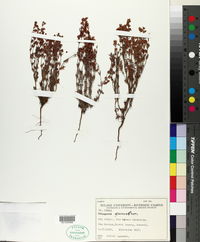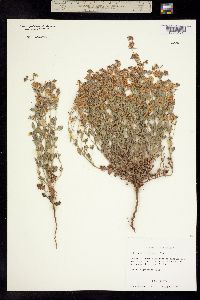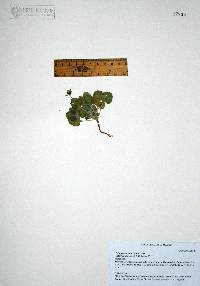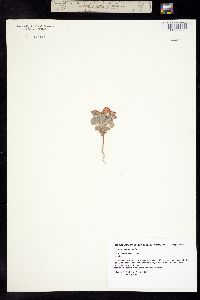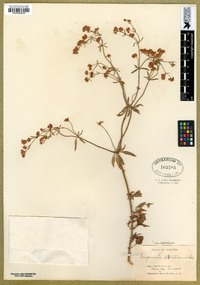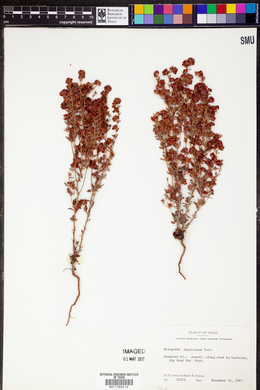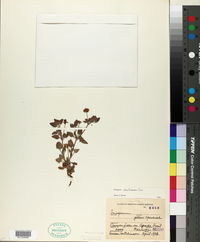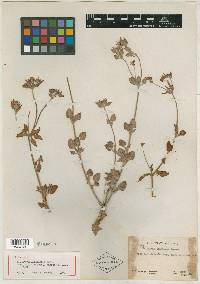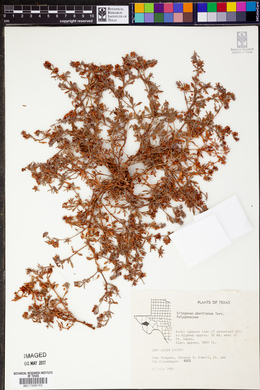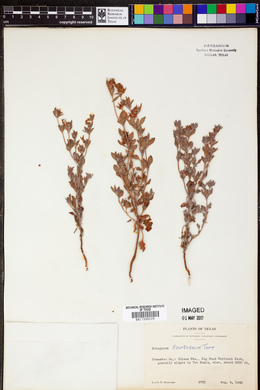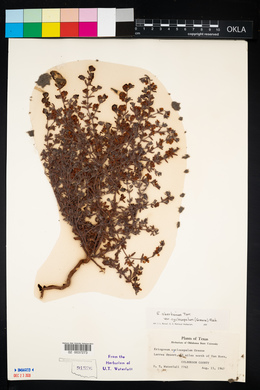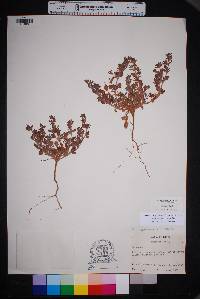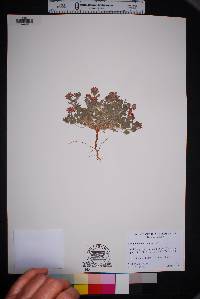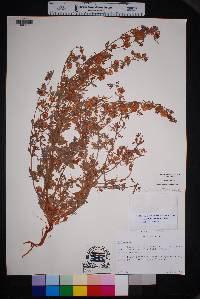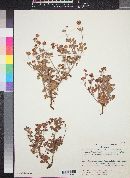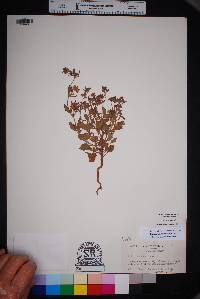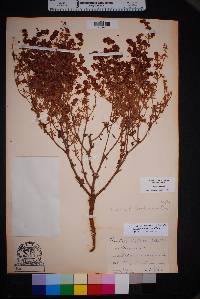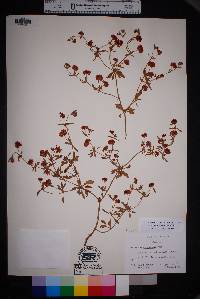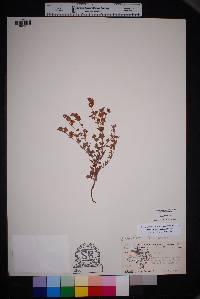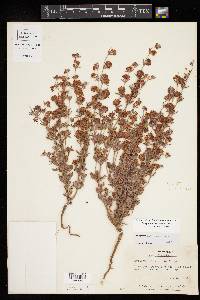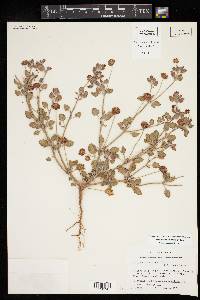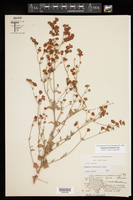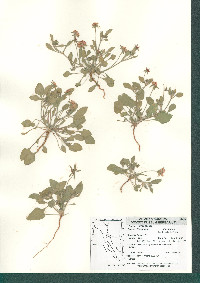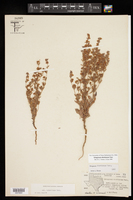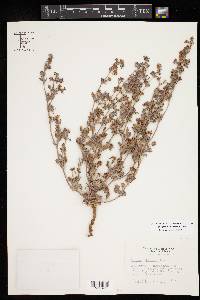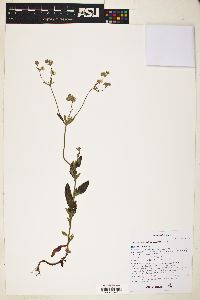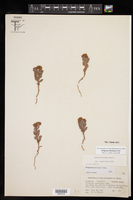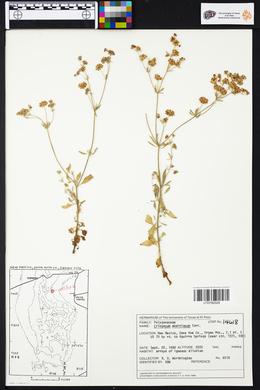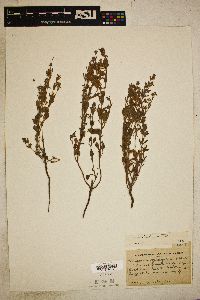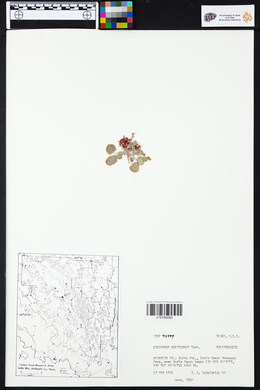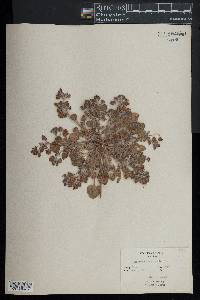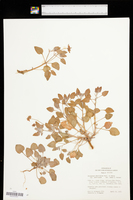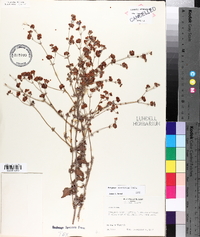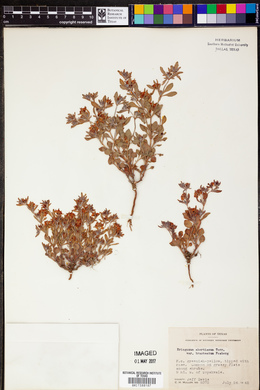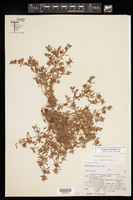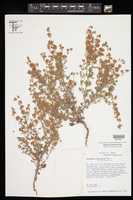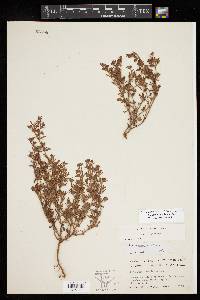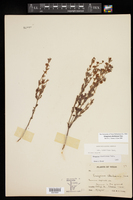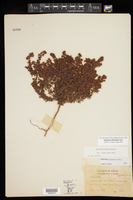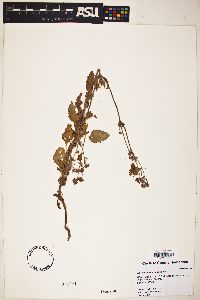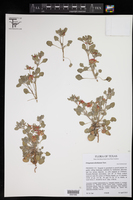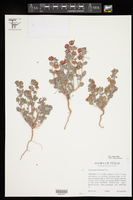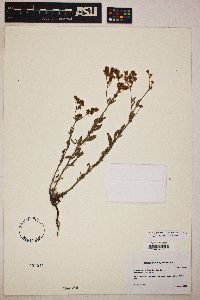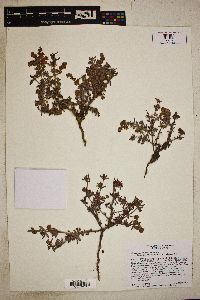
|
|
|
|
Family: Polygonaceae
Abert's buckwheat, more...Abert's Wild Buckwheat, skeleton weed, Abert buckwheat
[Eriogonum abertianum var. bracteatum Fosberg] |
Herbs, erect or spreading, annual, 0.5-6(-7) dm, hirsute, greenish, grayish, tawny, or reddish. Stems: caudex absent; aerial flowering stems prostrate to erect, solid, not fistulose, 0.1-1 dm, appressed-hirsute. Leaves basal and cauline; basal: petiole 0.5-6 cm, villous to hoary, blade oblong to obovate, 1-4 × 1-3 cm, villous to hoary-tomentose and greenish, tawny, or reddish on both surfaces, margins plane, occasionally crenulate; cauline sessile, blade linear, lanceolate, or narrowly obovate, 1-4 × 0.3-2 cm, similar to basal blade. Inflorescences cymose, open to diffuse, 5-40(-60) × 5-50 cm; branches hirsute; bracts 3-6, semileaflike, 2-10 × 1-3 mm. Peduncles ascending to erect, mostly straight, slender, 0.5-6 cm, villous to hoary-tomentose. Involucres broadly campanulate, 2-3 × 2-3 mm, villous-canescent; teeth 5, lobelike, usually reflexed, 4-6 mm. Flowers 3-4.5 mm; perianth white to pale yellow in early anthesis, becoming reddish or rose, glabrous; tepals dimorphic, those of outer whorl orbiculate-cordate, those of inner whorl lanceolate to spatulate; stamens mostly exserted, 1.5-3.5 mm; filaments mostly pilose proximally. Achenes brown to dark brown, lenticular, 0.6-1 mm, glabrous. 2n = 40. Flowering year-round. Sandy, gravelly, or clayey flats, washes, and slopes, mixed grassland, saltbush, greasewood, creosote bush, blackbrush, and manzanita communities, oak and conifer woodlands; 400-2500 m; Ariz., N.Mex., Tex.; Mexico (Coahuila, Chihuahua, Sonora, San Luis Potosí). Eriogonum abertianum is widespread and common to abundant or even locally weedy. It is basically a species of the Chihuahuan and Sonoran deserts, ranging from San Luis Potosí and Sonora in northern Mexico to western Texas and much of New Mexico and Arizona. This species is exceedingly variable and can be differentiated into several geographic and seasonal phases (C. C. Baskin et al. 1993; G. A. Fox 1989, 1990, 1990b). Variety abertianum (including E. pinetorum) is a more northern and western, summer- and fall-flowering expression, with an erect habit and a cymose-paniculate inflorescence when the plants are in fruit. A vernal phase (var. villosum) of this northern form occurs throughout much of the same range (mainly Arizona, New Mexico, and the Sonoran Desert of Mexico). It is a hairier and more spreading expression, with elongated inflorescence branches bearing more floriferous involucres. Variety ruberrimum (including E. cyclosepalum) is the more southern, summer- to fall-flowering expression (mainly New Mexico, Texas, and the Chihuahuan Desert of Mexico) with a prostrate to spreading, compact habit and a racemose inflorescence at full maturity. There is a vernal expression of this as well; it differs from the vernal form of var. abertianum in having longer peduncles. There are no sharp morphologic or geographic boundaries for any of these expressions, and while the fruiting extremes are clearly distinguishable, far too many specimens are impossible to place satisfactorily. The Navajo (Diné) people use these plants as a lotion for both themselves and their horses (P. A. Vestal 1952).
Wiggins 1964, Kearney and Peebles 1969, FNA 2005 Duration: Annual Nativity: Native Lifeform: Forb/Herb General: Annual herb, 5-60 cm tall; stems erect or spreading, profusely branched from near the base, green or grayish to reddish, appressed-hirsute. Leaves: In a spreading basal rosette and alternate along the stems; basal leaves ovate, 1-4 cm long and 1-3 cm wide, on petioles up to 6 cm long. Upper stem leaves usually sessile, the blades obovate-lanceolate to linear, 1-4 cm long and 5-20 mm wide. All leaves loosely villous to hoary. Flowers: White to pink, arranged in tight rounded clusters of several flowers held together by a cup-shaped structure called an involucre; involucres arranged in open cymose inflorescenses, these up to 50 cm wide and long, with hairy branches; each individual flower is 3-4 mm high, with 6 ruffled, papery, petal-like tepals, these white to pale yellow and often tinted with rose, with deep-rose colored midribs. Fruits: Achenes lens-shaped, less than 1 mm long, dark brown and smooth or transversely rugulose (wrinkled). Ecology: Found on sandy plains, washes, and granitic hills, from 1,500-7000 ft (457-2134 m); flowers March-September. Distribution: AZ, NM, TX; south to n MEX. Notes: One of our most common annual buckwheats with several varieties known. It is annual and can be variable in growth form, as erect and branching above, or small with few stems from a basal rosette, or prostrate and spreading; the leaves are oval-shaped, with long, shaggy hairs and wavy margins and are smaller higher up the stem. Immediately obvious (in some populations) are the inflorescences which are often round balls of white flowers with red stripes down the center of each petal and many yellow stamens in the centers; the inflorescences can also be elongated on some. Ethnobotany: Navajo used it to make a lotion for skin cuts on humans and horses. Etymology: Eriogonum is from the Greek erion, wool, and gony, knee, alluding to the hairy nodes of the first species described, E. tomentosum; abertiaum is named for James William Abert (1820-1897), a US Army officer who led exploratory expeditions in the American West. Synonyms: Eriogonum cyclosepalum, Eriogonum pinetorum Editor: SBuckley 2010, FSCoburn 2015, AHazelton 2017 |
|
|
|

